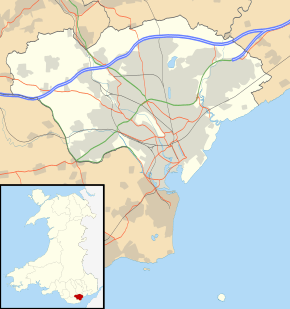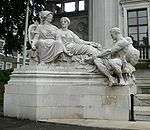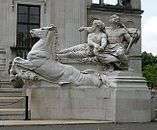Glamorgan Building
The Glamorgan Building (Welsh: Adeilad Morgannwg) is an Edwardian former county hall located in Cardiff, Wales. It is situated at Cathays Park on King Edward VII Avenue. Formerly the home of Glamorgan County Council and then Mid Glamorgan County Council, the building was acquired by Cardiff University in 1997 and is now home to the university's School of Social Sciences and the School of Geography and Planning. It is a Grade I listed building.[1]
| Glamorgan Building | |
|---|---|
Glamorgan Building | |
| Location | Cardiff |
| Coordinates | 51.4859°N 3.1815°W |
| Built | 1912 |
| Architect | E. Vincent Harris Thomas A. Moodie |
| Architectural style(s) | Beaux-Arts |
Listed Building – Grade I | |
| Designated | 25 January 1966 |
| Reference no. | 13738 |
 Location of Glamorgan Building in Cardiff | |
History
Background
Following the implementation of the Local Government Act 1888, which established county councils in every county, it became necessary to find a meeting place for Glamorgan County Council.[2]
Design and construction
The building was designed by Vincent Harris OBE (1876–1971) and Thomas Anderson Moodie (1874–1948), who won the design competition for the building in 1909.[3] It was built at a cost of £67,724,[4] was completed in 1911 and opened as Glamorgan County Hall in 1912.[5] Outside the building, serving as reminders of Glamorgan's source of wealth, are two groups of statues by Albert Hodge (1875–1918), one representing navigation and the other coal mining.[6]
With the Local Government Act 1929, which transferred more powers to local authorities, a large extension was required. It was built to the rear of the University of Wales Registry to a design by Ivor Jones and Percy Thomas at a cost of £54,054[4] and opened in 1932.[4]
Recent history
Following the implementation of the Local Government Act 1972, which broke up Glamorgan County Council and established Mid Glamorgan County Council, the new county council took over the building.[2]
On 1 April 1996, under the Local Government (Wales) Act 1994, Mid Glamorgan County Council was abolished and the building was acquired by Cardiff University in 1997 and became home to the university's School of Social Sciences and the School of Geography and Planning.[7]
The Glamorgan Record Office, which had been based in the building since 1939, relocated to a purpose-built office in Leckwith next to the Cardiff City football stadium as Glamorgan Archives in 2009.[8]
References
- Cadw. "Glamorgan Building (13738)". National Historic Assets of Wales. Retrieved 15 April 2020.
- "Glamorgan County Council". Archives Hub. Retrieved 21 October 2019.
- Thomas Anderson Moodie, Dictionary of Scottish Architects. Retrieved 2012-03-13.
- Chappell, Edgar L. (1946). Cardiff's Civic Centre: A historical guide. Priory Press., pp. 41
- William Rees (1969), "The Reformed Borough, 1836-1914", Cardiff - A History Of The City, The Corporation of the City of Cardiff, p. 338
- Albert H. Hodge (1875–1918), Website of Bob Speel. Retrieved 2012-03-13.
- "These are all the grade one listed buildings in Cardiff". Wales Online. 10 December 2018. Retrieved 21 October 2019.
- "All Black souvenir comes to light". BBC News. 5 November 2009. Retrieved 18 December 2015.


